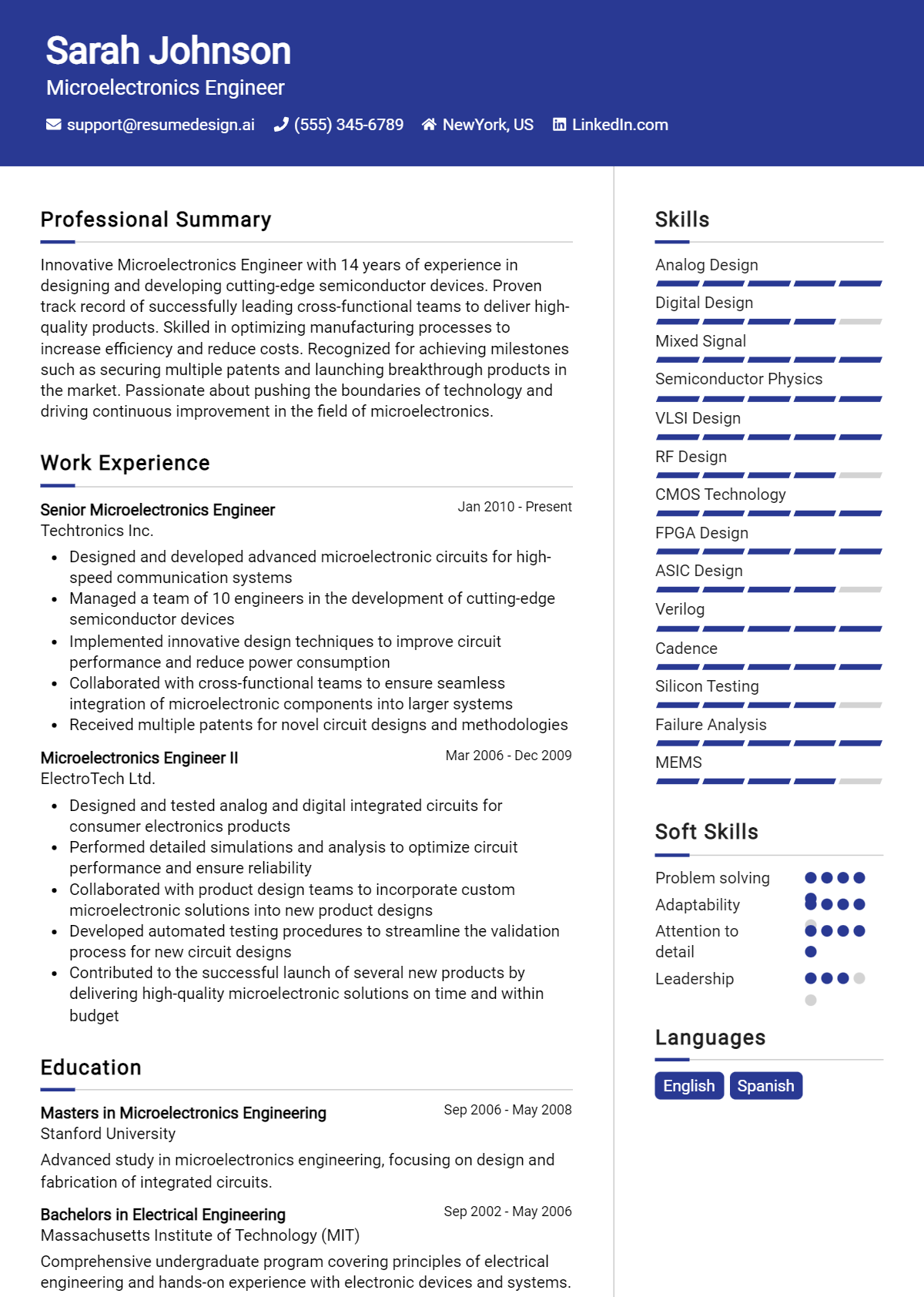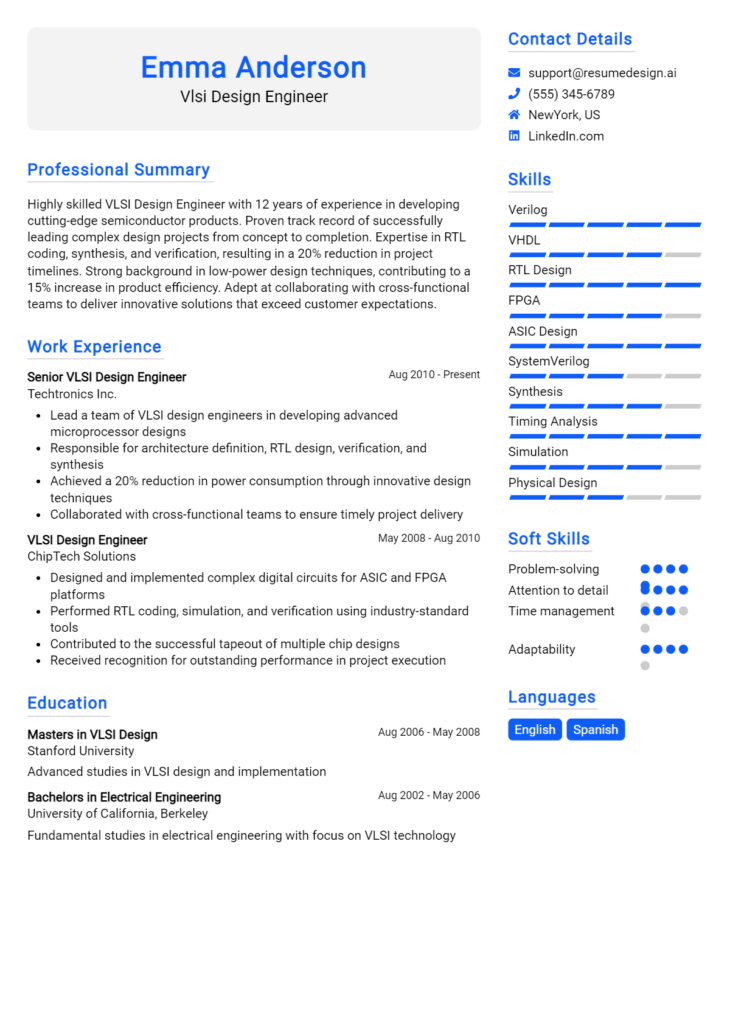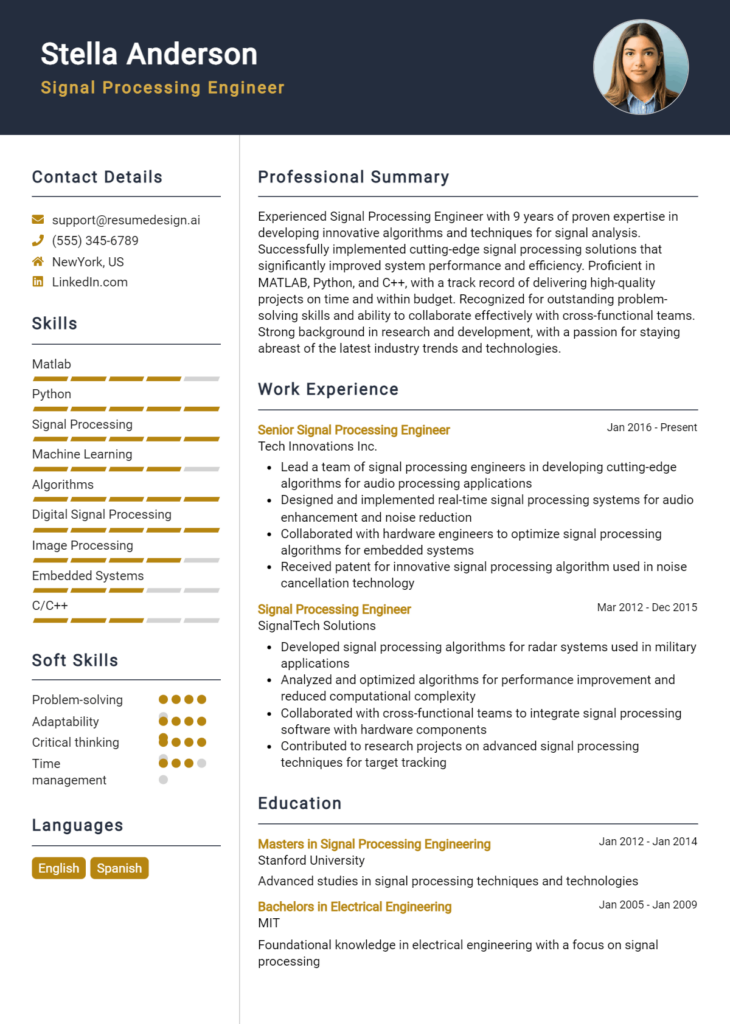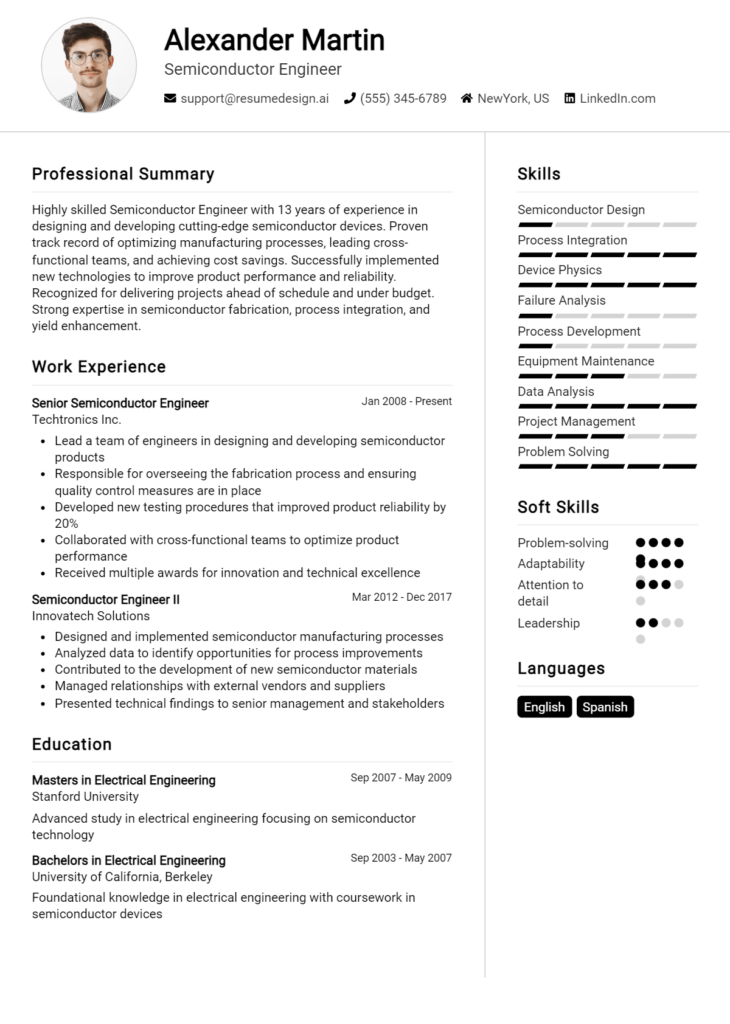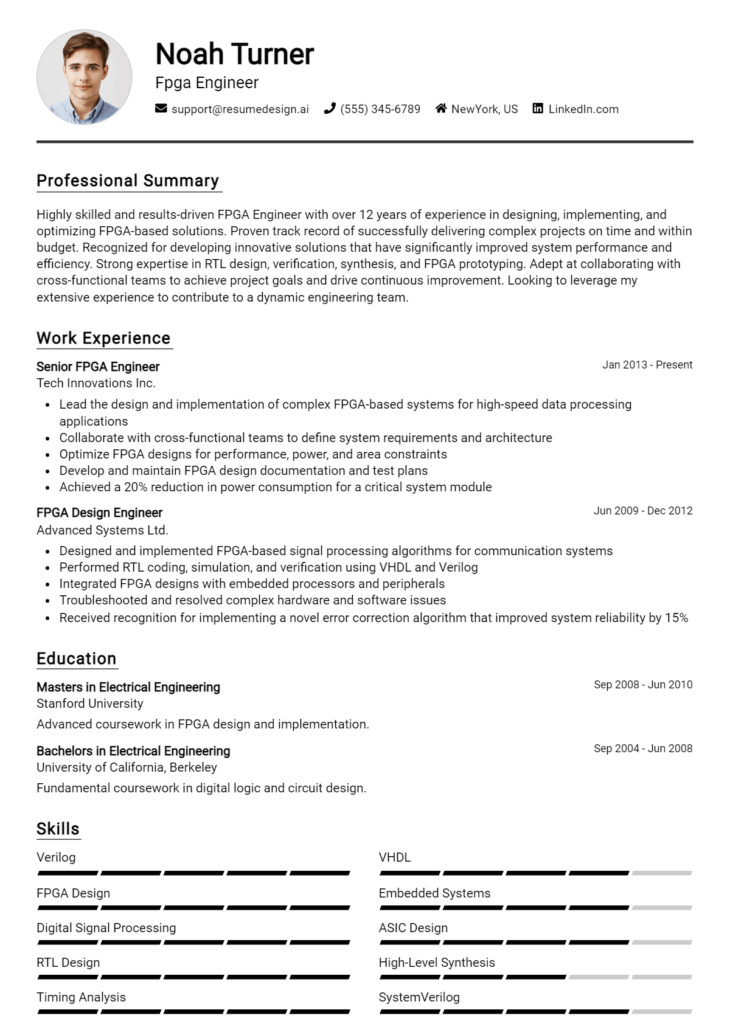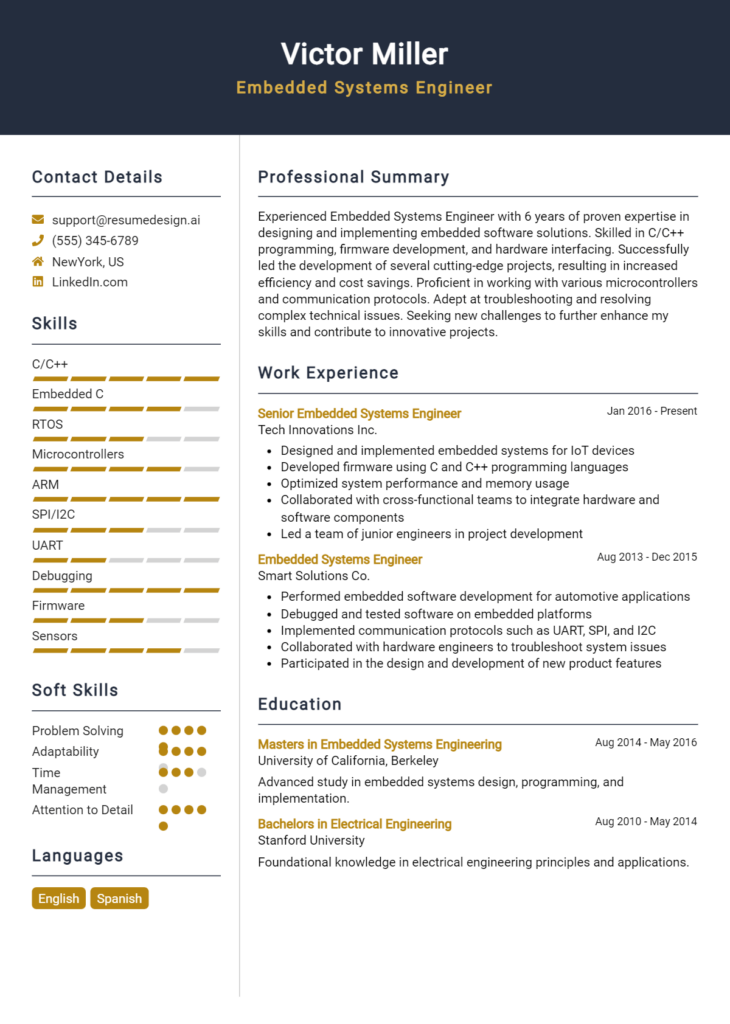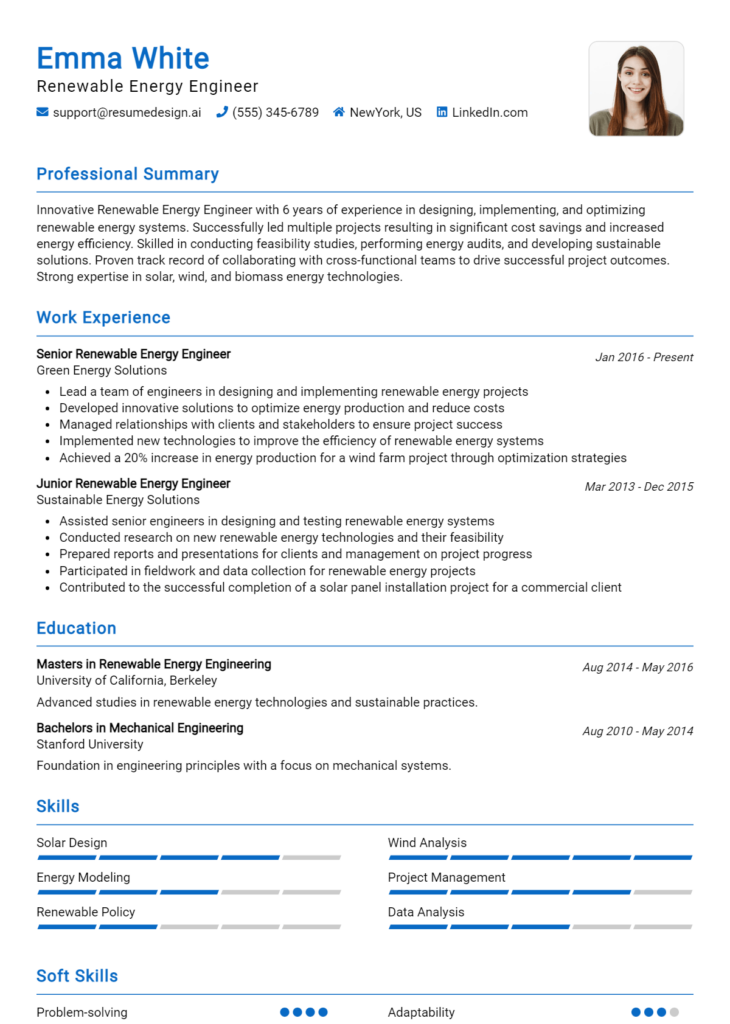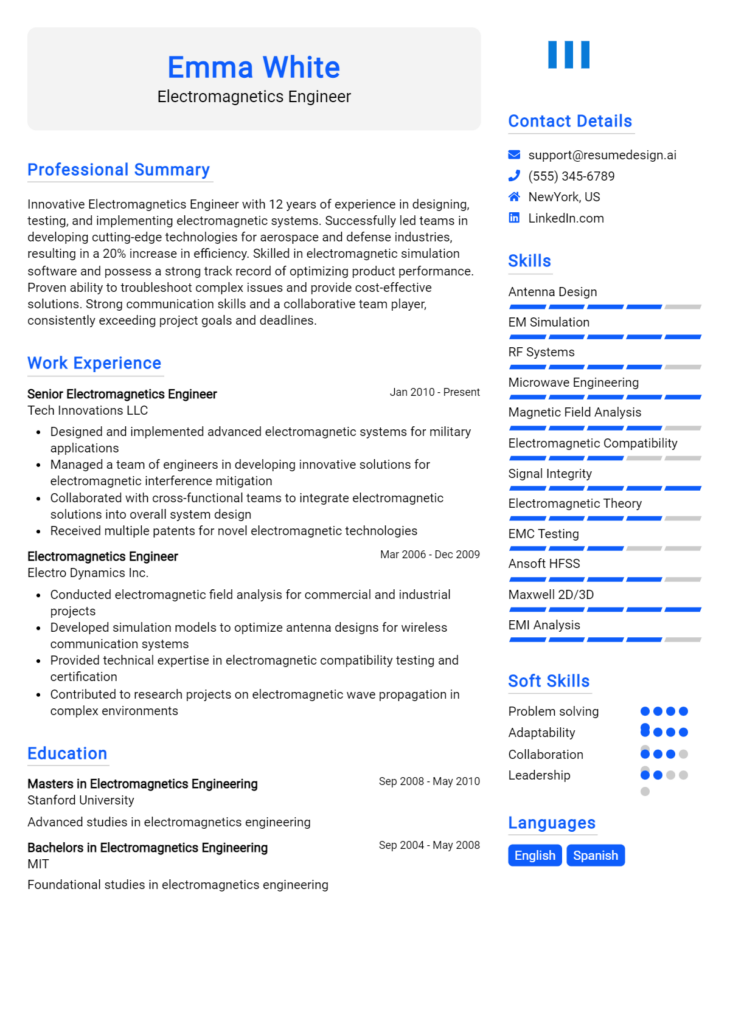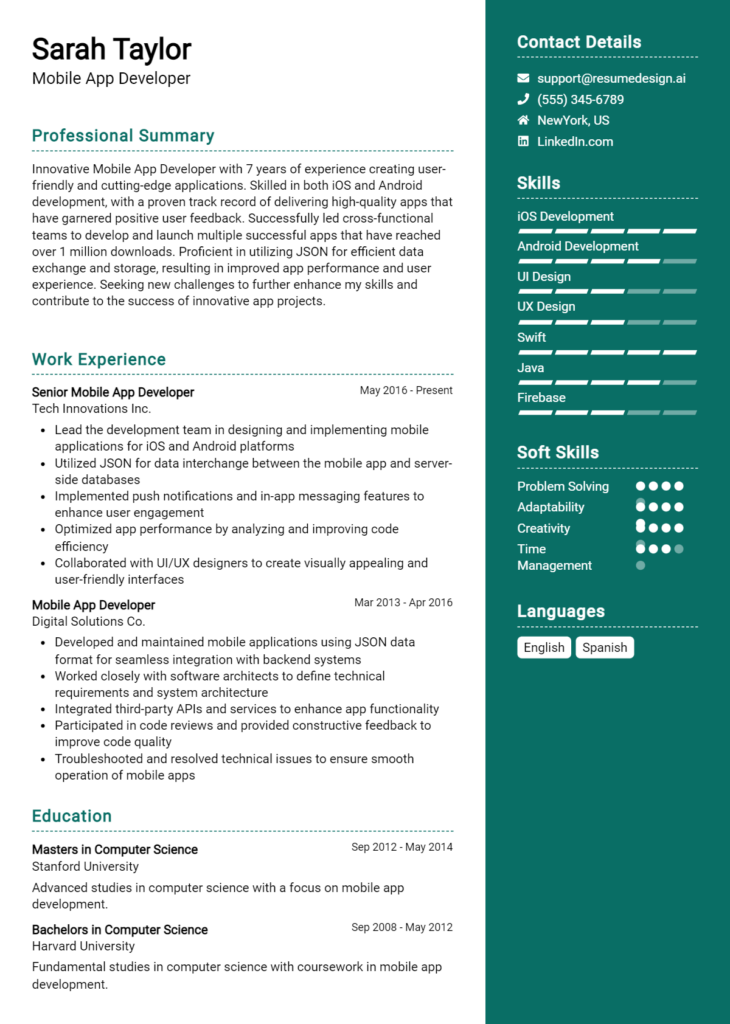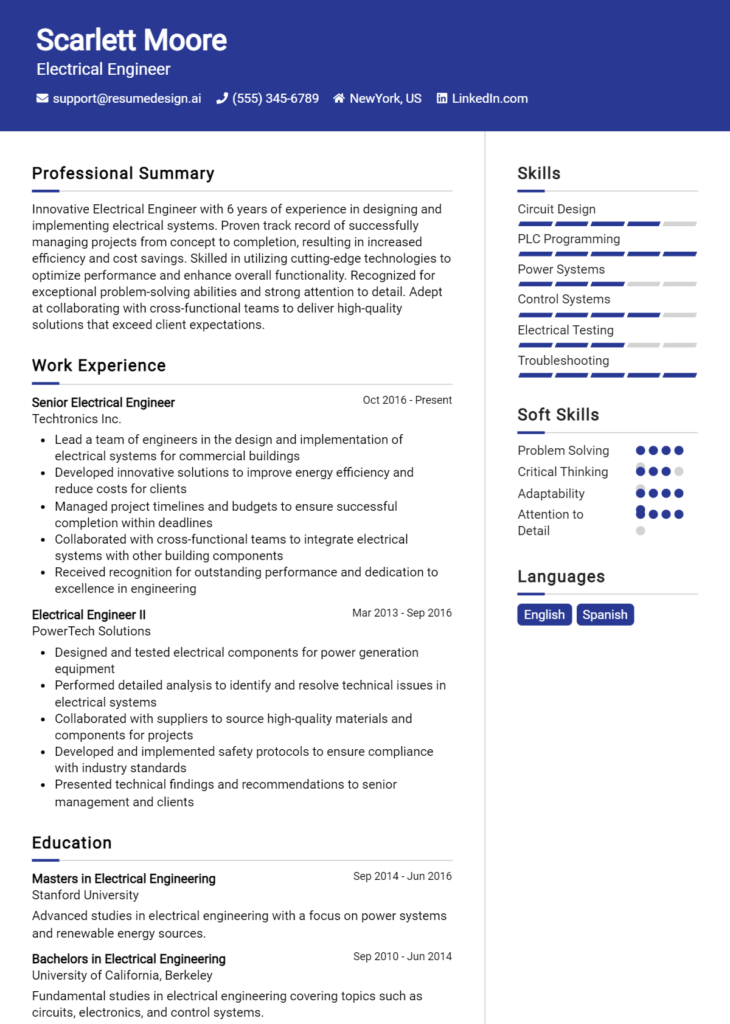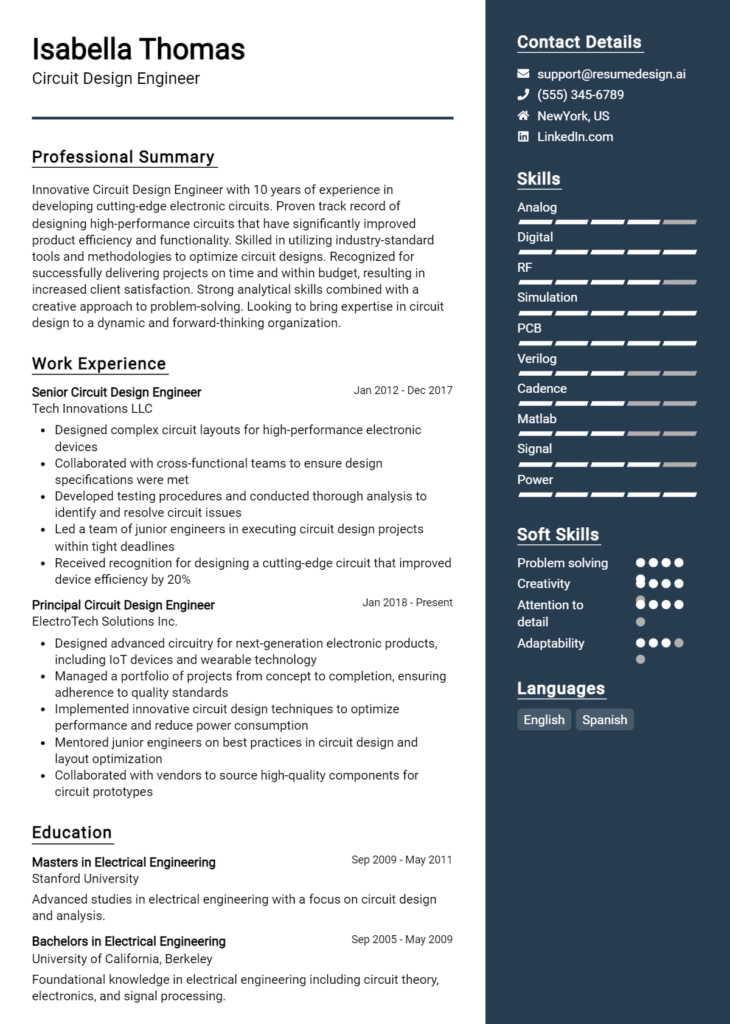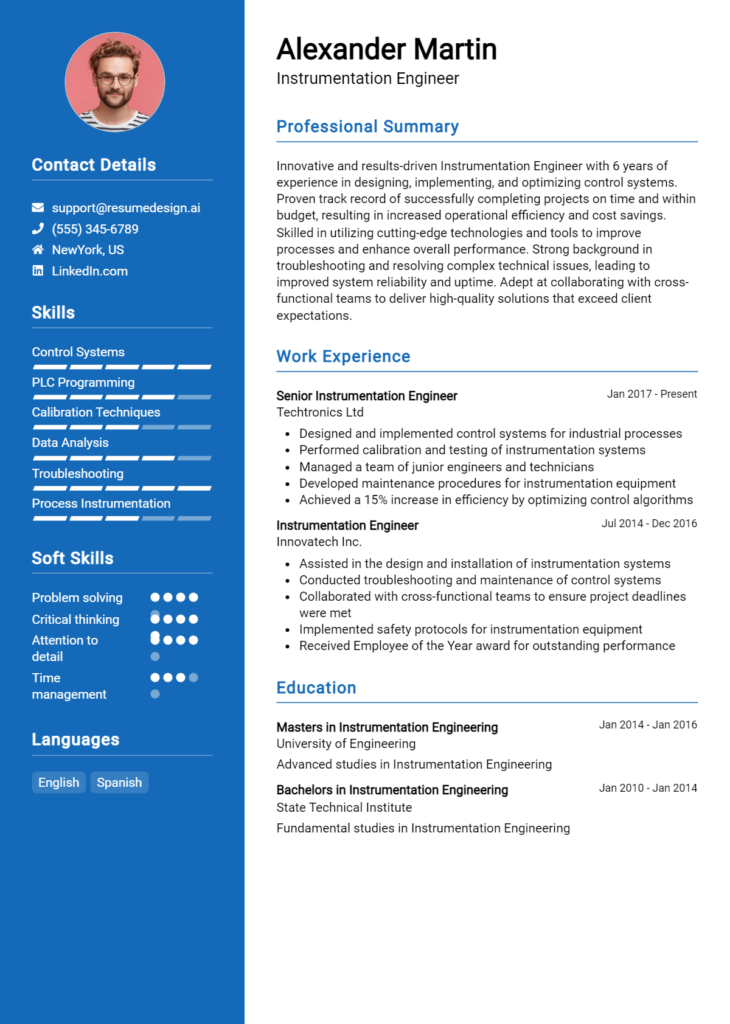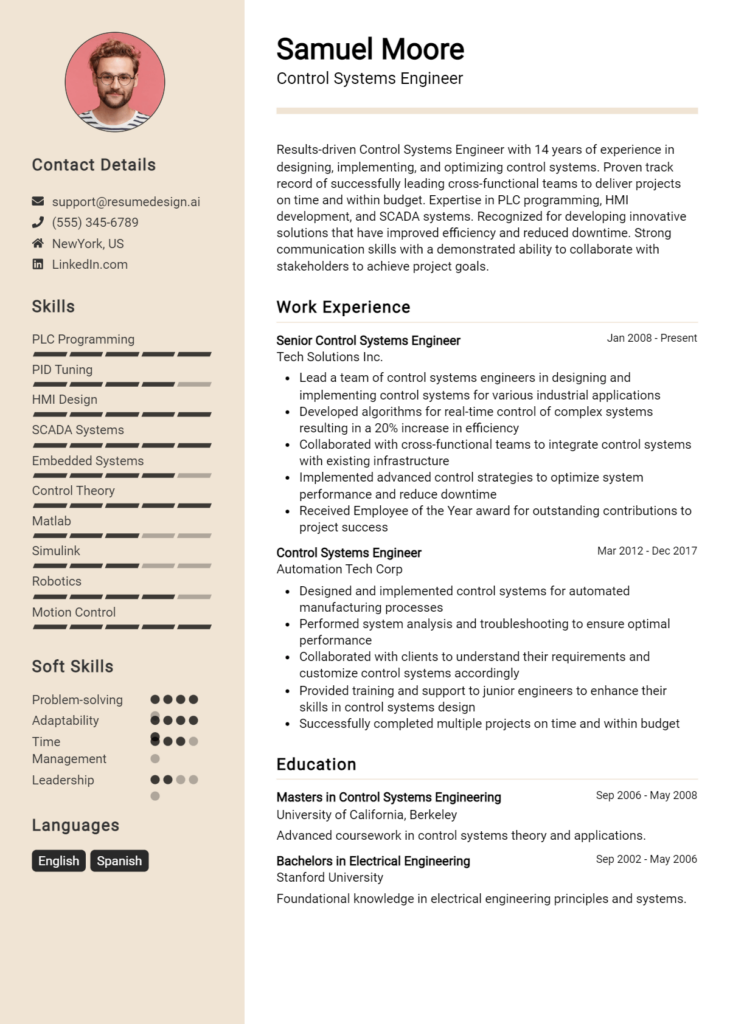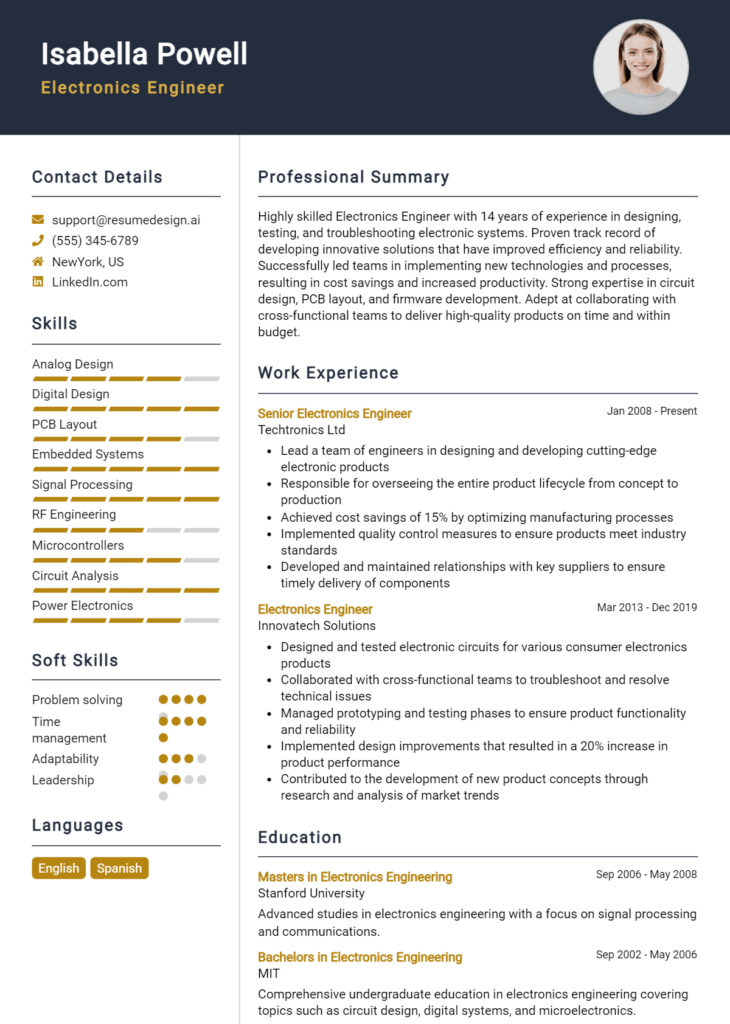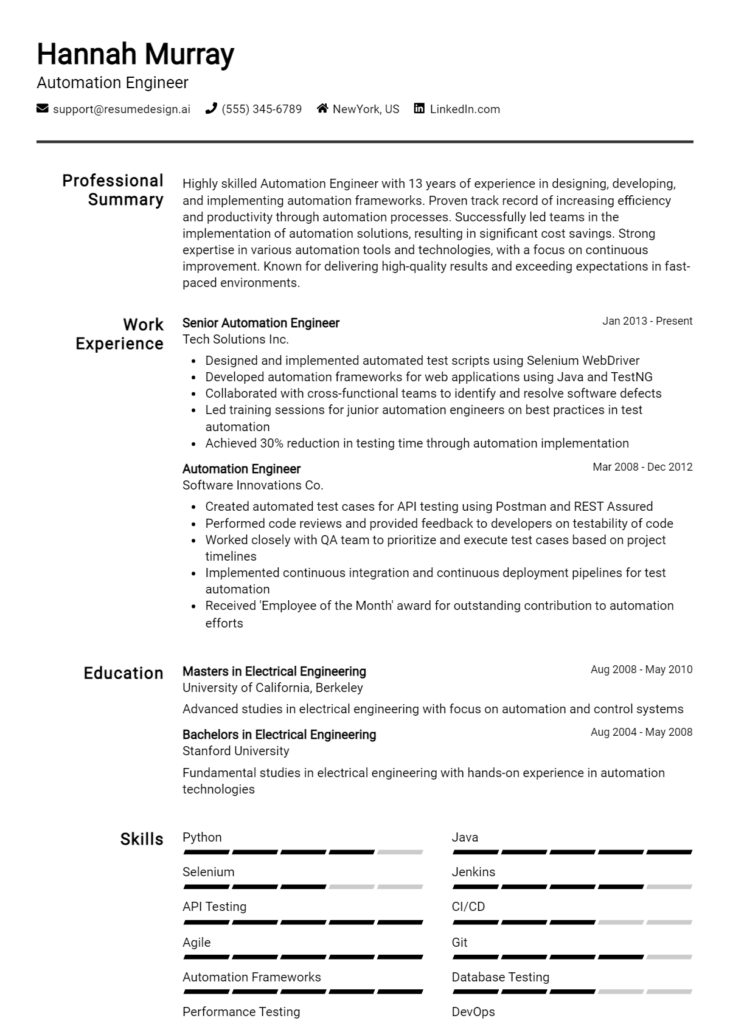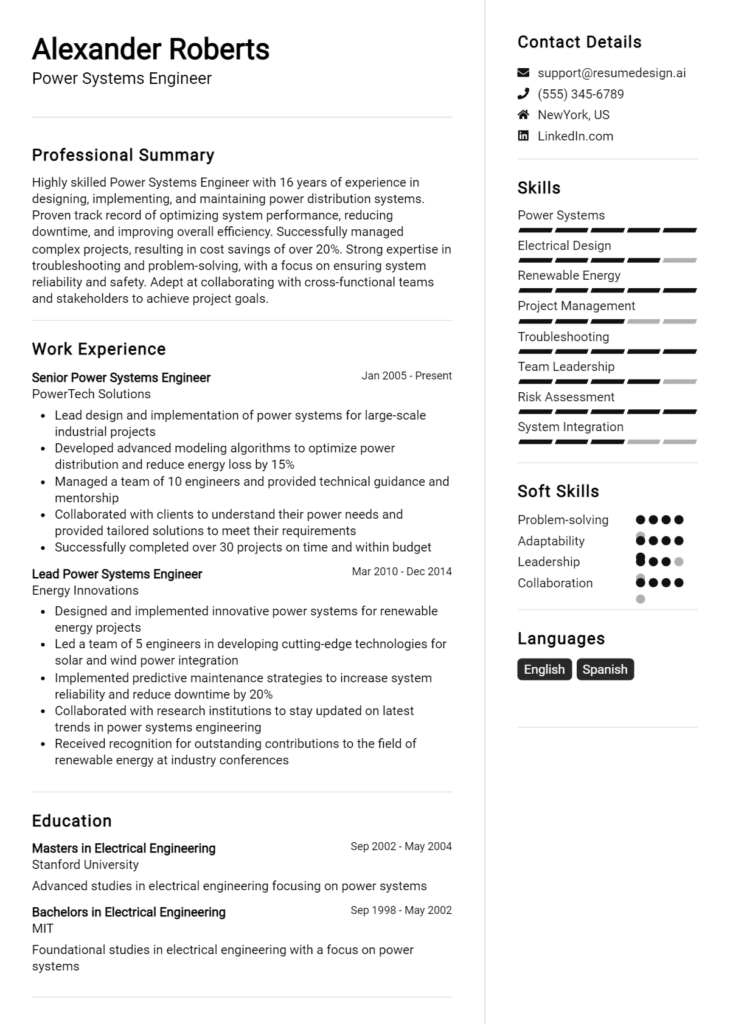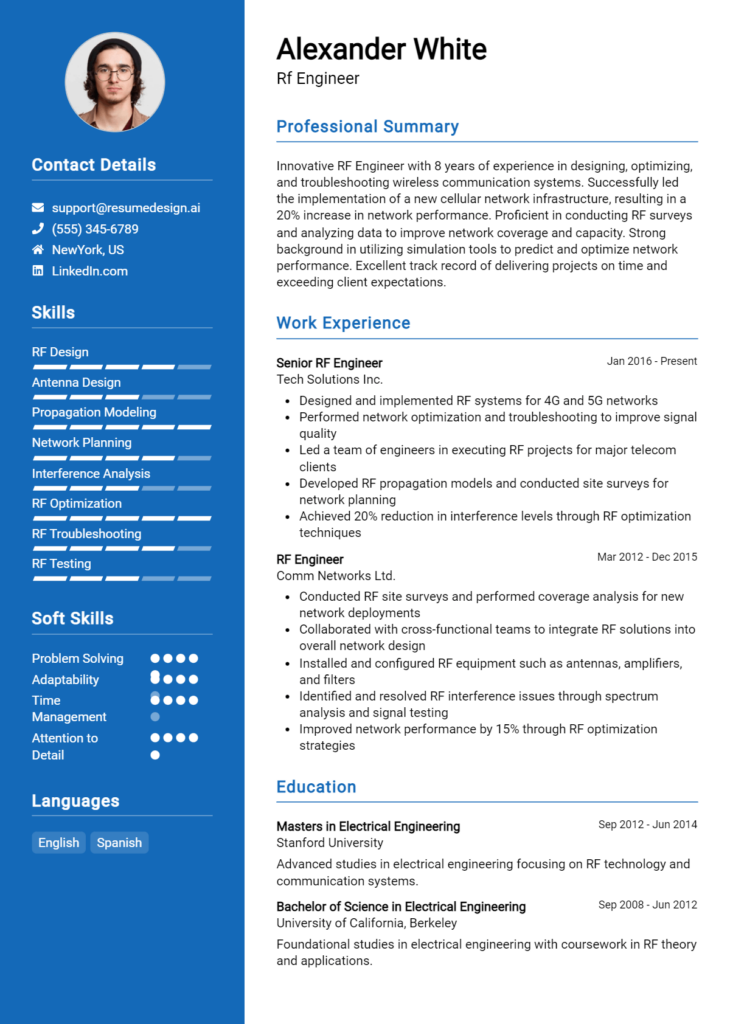Microelectronics Engineer Core Responsibilities
A Microelectronics Engineer is pivotal in designing, manufacturing, and testing microelectronic devices, bridging the gap between engineering, production, and quality assurance departments. Key responsibilities include circuit design, materials selection, and troubleshooting fabrication processes. Essential skills encompass technical knowledge of semiconductor physics, operational efficiency, and strong problem-solving abilities. These competencies directly contribute to the organization’s innovation and productivity goals. A well-structured resume can effectively showcase these qualifications, highlighting relevant experiences and technical proficiencies.
Common Responsibilities Listed on Microelectronics Engineer Resume
- Design and simulate microelectronic circuits and systems.
- Collaborate with cross-functional teams for product development.
- Conduct failure analysis and implement corrective actions.
- Perform testing and validation of microelectronic devices.
- Optimize manufacturing processes for cost-effectiveness.
- Stay updated with industry trends and technological advancements.
- Prepare technical documentation and reports.
- Ensure compliance with safety and quality standards.
- Develop and execute project timelines and milestones.
- Utilize CAD software for design and modeling.
- Support troubleshooting and maintenance of equipment.
- Train and mentor junior engineers and technicians.
High-Level Resume Tips for Microelectronics Engineer Professionals
In the competitive field of microelectronics engineering, a well-crafted resume is essential for making a strong first impression on potential employers. Your resume serves as your initial introduction, showcasing not only your technical skills and experience but also your achievements in the industry. It needs to reflect your unique qualifications and demonstrate how you can contribute to the organization's success. This guide will provide practical and actionable resume tips specifically tailored for Microelectronics Engineer professionals, helping you to stand out in the job market.
Top Resume Tips for Microelectronics Engineer Professionals
- Tailor your resume to the specific job description by aligning your skills and experiences with the requirements outlined in the posting.
- Highlight relevant experience in microelectronics design, fabrication, testing, and quality assurance to demonstrate your expertise.
- Quantify your achievements by using metrics and specific outcomes, such as improved yield rates or reduced production costs.
- Include industry-specific skills such as knowledge of semiconductor processes, circuit design, and software tools relevant to microelectronics.
- Showcase projects that you have led or contributed to, detailing your role and the impact of the project on the organization.
- Utilize keywords from the job description to pass through Applicant Tracking Systems (ATS) and increase the chances of your resume being seen by hiring managers.
- Keep the design clean and professional, using clear headings and bullet points for easy readability.
- Incorporate any relevant certifications or training that enhance your qualifications in microelectronics engineering.
- Be concise; limit your resume to one or two pages and focus on the most pertinent information that aligns with the job you’re applying for.
By implementing these tips, you can significantly increase your chances of landing a job in the Microelectronics Engineer field. A tailored and polished resume will not only showcase your skills and achievements but also demonstrate your commitment to excellence, making you a compelling candidate for potential employers.
Why Resume Headlines & Titles are Important for Microelectronics Engineer
In the competitive field of microelectronics engineering, a well-crafted resume headline or title serves as a crucial first impression for potential employers. A strong headline captures the attention of hiring managers, providing a succinct summary of a candidate's key qualifications and expertise in just a few impactful words. This brief yet powerful statement should be concise, relevant, and directly aligned with the specific job being applied for, allowing candidates to effectively highlight their suitability for the role at a glance.
Best Practices for Crafting Resume Headlines for Microelectronics Engineer
- Keep it concise: Aim for no more than 10-12 words to maintain clarity.
- Be role-specific: Tailor the headline to the job description and key responsibilities.
- Highlight key strengths: Focus on your most relevant skills, experiences, or achievements.
- Use impactful language: Choose action-oriented words that convey confidence and expertise.
- Avoid jargon: Ensure the language is accessible and understandable to a broad audience.
- Include quantifiable results: Mention significant accomplishments that demonstrate your impact.
- Use industry keywords: Incorporate relevant terms that align with the microelectronics field.
- Make it compelling: Create a sense of urgency or importance to draw in the reader.
Example Resume Headlines for Microelectronics Engineer
Strong Resume Headlines
Innovative Microelectronics Engineer with 7+ Years in Circuit Design
Experienced Microelectronics Specialist Focused on High-Performance Semiconductor Solutions
Results-Driven Engineer with Proven Expertise in IC Design and Fabrication
Microelectronics Engineer Skilled in Advanced Signal Processing and System Integration
Weak Resume Headlines
Engineer Looking for Opportunities
Microelectronics Graduate Seeking Job
Experienced Professional Available for Work
Strong headlines are effective because they provide immediate clarity and context about a candidate's qualifications, making it easier for hiring managers to see the value they can bring to the organization. They highlight specific skills, experiences, or achievements that are directly relevant to the role. In contrast, weak headlines tend to be generic and lack focus, failing to communicate the candidate's unique strengths or contributions, which diminishes their impact and leaves a less memorable impression.
Writing an Exceptional Microelectronics Engineer Resume Summary
A well-crafted resume summary is essential for a Microelectronics Engineer, as it serves as the first impression that captures the attention of hiring managers. In a highly specialized field like microelectronics, a strong summary succinctly highlights key skills, relevant experience, and notable accomplishments that align with the job requirements. This concise overview is crucial in making the candidate stand out among numerous applications, allowing hiring managers to quickly assess their suitability for the position. A tailored resume summary not only conveys the candidate's technical expertise but also demonstrates their understanding of the specific role and company culture, thereby increasing their chances of securing an interview.
Best Practices for Writing a Microelectronics Engineer Resume Summary
- Quantify achievements: Use numbers and metrics to demonstrate the impact of your work.
- Focus on relevant skills: Highlight specific technical skills that are pertinent to the job description.
- Tailor the summary: Customize your summary for each position to reflect the keywords and requirements stated in the job posting.
- Be concise: Aim for 2-4 sentences that encapsulate your qualifications without excessive detail.
- Showcase accomplishments: Mention notable projects or contributions that illustrate your expertise and value.
- Use industry terminology: Employ specific jargon and phrases that resonate with hiring managers in the microelectronics field.
- Highlight problem-solving abilities: Emphasize your capacity to address challenges and deliver innovative solutions.
- Maintain a professional tone: Ensure your language is formal yet engaging, reflecting your professionalism in the field.
Example Microelectronics Engineer Resume Summaries
Strong Resume Summaries
Results-driven Microelectronics Engineer with over 7 years of experience in designing and developing high-performance semiconductor devices. Successfully led a team project that reduced production costs by 30% while enhancing device efficiency by 20%. Proficient in CAD tools and simulation software, with a strong background in materials science and device fabrication.
Detail-oriented Microelectronics Engineer specializing in RF circuit design and testing, with a proven track record of delivering innovative solutions for telecommunications applications. Spearheaded the development of a novel RF amplifier that improved signal integrity by 25%, leading to a significant increase in client satisfaction.
Dynamic Microelectronics Engineer with expertise in microfabrication techniques and process optimization. Achieved a 40% reduction in cycle time for silicon wafer processing through the implementation of lean manufacturing principles. Adept at collaborating with cross-functional teams to drive product development from concept to production.
Weak Resume Summaries
Microelectronics Engineer with experience in various projects and a background in engineering. I am looking for a challenging position in a reputable company.
Dedicated engineer with skills in microelectronics and a desire to contribute to team success. I have worked on several engineering tasks and am open to learning new technologies.
The examples provided illustrate the stark contrast between strong and weak resume summaries. Strong summaries effectively quantify achievements, specify relevant skills, and highlight direct applicability to the role, making them impactful and compelling. In contrast, weak summaries lack detail and specificity, failing to convey the candidate's qualifications or unique contributions, which diminishes their appeal to hiring managers.
Work Experience Section for Microelectronics Engineer Resume
The work experience section of a Microelectronics Engineer resume plays a crucial role in presenting the candidate's qualifications and capabilities. This section not only highlights the technical skills acquired through previous roles but also demonstrates the ability to manage teams and deliver high-quality products. By quantifying achievements and aligning experiences with industry standards, candidates can effectively showcase their professional growth and impact in the field of microelectronics, making them stand out to potential employers.
Best Practices for Microelectronics Engineer Work Experience
- Highlight relevant technical skills specific to microelectronics, such as circuit design, semiconductor fabrication, and reliability testing.
- Quantify achievements with metrics, such as percentage improvements in yield or cost savings realized through process optimizations.
- Describe leadership experiences, including managing teams on projects and mentoring junior engineers.
- Focus on collaboration efforts by detailing cross-functional work with other departments like software development and manufacturing.
- Use action verbs to convey impact, such as "designed," "implemented," "led," or "optimized."
- Tailor the work experience to align with the job description and industry trends to demonstrate relevance.
- Include any certifications or specialized training that enhance your technical expertise in microelectronics.
- Keep descriptions concise and focused, avoiding unnecessary jargon that may detract from clarity.
Example Work Experiences for Microelectronics Engineer
Strong Experiences
- Led a team of engineers in the design and implementation of a new semiconductor fabrication process, resulting in a 20% increase in production yield and a $500,000 reduction in annual costs.
- Collaborated with cross-functional teams to develop a state-of-the-art microprocessor, achieving a 15% performance improvement over the previous model, which enhanced customer satisfaction ratings by 30%.
- Implemented a quality control system that decreased defect rates by 25%, significantly improving product reliability and reducing warranty claims.
- Mentored five junior engineers, providing training on advanced circuit design techniques, which led to improved project delivery times by 40% across the team.
Weak Experiences
- Worked on various electronics projects without specifying contributions or outcomes.
- Assisted in team tasks related to microelectronics without detailing specific roles or impacts.
- Involved in design processes but did not quantify results or improvements.
- Participated in meetings about project updates without clarifying the significance of contributions to project success.
The examples categorized as strong experiences showcase quantifiable outcomes, technical leadership, and effective collaboration, all of which are critical in the microelectronics field. In contrast, the weak experiences lack specificity and measurable results, making them less impactful and failing to convey the candidate's true capabilities. By presenting clear and detailed achievements, candidates can effectively demonstrate their value to potential employers.
Education and Certifications Section for Microelectronics Engineer Resume
The education and certifications section of a Microelectronics Engineer resume is crucial in establishing the candidate's foundational knowledge and specialized skills in the field. This section serves to highlight the academic background and relevant industry certifications that validate the candidate's expertise in microelectronics. It showcases ongoing commitment to professional development, emphasizing coursework and training that align with the demands of the industry. By including relevant degrees and certifications, candidates can significantly enhance their credibility and demonstrate their alignment with the job role, making them more attractive to potential employers.
Best Practices for Microelectronics Engineer Education and Certifications
- Focus on degrees and certifications that are directly relevant to microelectronics, such as Electrical Engineering or Microelectronics certifications.
- Include specific coursework that demonstrates expertise in key areas, such as semiconductor physics, circuit design, and fabrication processes.
- List only certifications that are current and recognized within the industry, such as Certified Microelectronics Technician (CMT).
- Highlight advanced degrees (Master’s or Ph.D.) if applicable, as they indicate a deeper level of knowledge.
- Use a clear format to make it easy for hiring managers to quickly assess qualifications.
- Include any specialized training or workshops that showcase your commitment to continuous learning.
- Provide dates of graduation and certification to indicate recency and relevance.
- Tailor this section to match the specific requirements listed in the job description.
Example Education and Certifications for Microelectronics Engineer
Strong Examples
- Master of Science in Electrical Engineering, specializing in Microelectronics, University of California, Berkeley, 2021
- Certified Microelectronics Technician (CMT), 2022
- Relevant Coursework: Semiconductor Device Physics, Integrated Circuit Design, and MEMS Fabrication Techniques
- Bachelor of Science in Microelectronics Engineering, Georgia Institute of Technology, 2019
Weak Examples
- Associate Degree in General Studies, Community College, 2015
- Certification in Basic Computer Skills, 2018
- High School Diploma, 2010
- Outdated certification in Electronics Repair, 2010
The examples provided are considered strong because they showcase relevant degrees and certifications that directly relate to the microelectronics field, indicating that the candidate possesses the necessary knowledge and skills. In contrast, the weak examples reflect qualifications that lack relevance to the position, such as general studies or outdated certifications, which do not demonstrate the candidate's expertise or commitment to the microelectronics engineering profession.
Top Skills & Keywords for Microelectronics Engineer Resume
In the competitive field of microelectronics engineering, showcasing relevant skills on your resume is crucial for standing out to potential employers. A well-crafted resume that highlights both hard and soft skills can demonstrate not only your technical expertise but also your ability to collaborate effectively and adapt to various challenges. Recruiters often look for specific skills that align with the job requirements, making it essential to tailor your resume accordingly. By including a comprehensive list of skills, you can provide a clear picture of your qualifications and increase your chances of landing an interview. For guidance on how to effectively incorporate skills into your resume, explore additional resources.
Top Hard & Soft Skills for Microelectronics Engineer
Soft Skills
- Problem-solving
- Attention to detail
- Communication
- Team collaboration
- Time management
- Critical thinking
- Adaptability
- Creativity
- Project management
- Analytical skills
- Leadership
- Interpersonal skills
- Decision-making
- Conflict resolution
- Organizational skills
- Initiative
- Empathy
- Open-mindedness
Hard Skills
- Semiconductor device physics
- Circuit design and simulation
- VLSI technology
- CAD software proficiency (e.g., Cadence, SPICE)
- Fabrication techniques
- Materials science
- Signal processing
- Testing and validation
- Embedded systems design
- RF design
- PCB design and layout
- EDA tools expertise
- Failure analysis
- Product development lifecycle
- Quality assurance methods
- Technical documentation
- Software programming (e.g., Python, C++)
- Data analysis and modeling
In addition to highlighting these skills, it is also important to detail your work experience effectively, as this will provide context and evidence of your capabilities.
Stand Out with a Winning Microelectronics Engineer Cover Letter
Dear Hiring Manager,
I am writing to express my interest in the Microelectronics Engineer position at [Company Name], as advertised on [where you found the job listing]. With a Master’s degree in Electrical Engineering and over five years of hands-on experience in semiconductor fabrication and electronic circuit design, I am excited about the opportunity to contribute to your innovative team. My background in microelectronics, coupled with my passion for developing cutting-edge technologies, aligns perfectly with the dynamic goals of [Company Name].
During my previous role at [Previous Company Name], I successfully led a project that focused on enhancing the performance of integrated circuits through novel design methodologies. By implementing advanced simulation techniques and collaborating closely with cross-functional teams, we were able to optimize device parameters, resulting in a 20% increase in efficiency. My proficiency in industry-standard software such as Cadence, SPICE, and MATLAB has further equipped me to tackle complex design challenges effectively.
I am particularly drawn to [Company Name] because of your commitment to sustainability and innovation in microelectronics. I am eager to bring my skills in design verification and testing, as well as my strong analytical capabilities, to help drive the development of next-generation microelectronic devices. I am enthusiastic about the possibility of working in an environment that fosters creativity and collaboration, and I am confident that my technical expertise and dedication to excellence would make a valuable addition to your team.
Thank you for considering my application. I look forward to the opportunity to discuss how my background, skills, and enthusiasms align with the needs of your team at [Company Name]. I am excited about the potential to contribute to your projects and help advance the field of microelectronics.
Sincerely,
[Your Name]
[Your Phone Number]
[Your Email Address]
Common Mistakes to Avoid in a Microelectronics Engineer Resume
When crafting a resume for a Microelectronics Engineer position, it's essential to present your qualifications and experience in a clear and compelling manner. However, many candidates make common mistakes that can diminish their chances of landing an interview. By avoiding these pitfalls, you can ensure that your resume effectively showcases your skills and aligns with the expectations of employers in the field of microelectronics.
Lack of Tailoring: Failing to customize your resume for each job application can lead to generic submissions that don’t resonate with hiring managers. Highlight relevant skills and experiences that specifically match the job description.
Overloading with Technical Jargon: While technical proficiency is crucial, using excessive jargon can alienate HR personnel who may not have a technical background. Balance technical terms with clear, understandable language.
Ignoring Soft Skills: Microelectronics engineering is not just about technical abilities; soft skills like teamwork, communication, and problem-solving are equally important. Neglecting to mention these can give an incomplete picture of your capabilities.
Neglecting Quantifiable Achievements: Simply listing job duties without quantifying your achievements can make your contributions seem less impactful. Use metrics and specific results to demonstrate your success in previous roles.
Inconsistent Formatting: A poorly formatted resume can be difficult to read and may come off as unprofessional. Ensure consistent font sizes, bullet points, and spacing throughout to create a polished appearance.
Using an Unprofessional Email Address: An unprofessional email address can detract from your application. Always use a professional-sounding email that includes your name.
Failing to Include Relevant Certifications: In the rapidly evolving field of microelectronics, relevant certifications can set you apart from other candidates. Omitting these can be a missed opportunity to showcase your qualifications.
Excessive Length: A lengthy resume can overwhelm hiring managers. Aim for a concise document that highlights your most relevant experiences and skills, ideally one page unless you have extensive experience.
Conclusion
As we have explored the essential skills, qualifications, and responsibilities of a Microelectronics Engineer, it's clear that this role demands a unique blend of technical expertise and innovative thinking. The field of microelectronics is rapidly evolving, requiring professionals to stay abreast of the latest technologies and methodologies. Key competencies include proficiency in semiconductor physics, circuit design, and testing processes, along with strong analytical skills and attention to detail.
Moreover, the importance of effective communication and teamwork cannot be understated, as Microelectronics Engineers often collaborate with cross-functional teams to bring projects to fruition. Continuous learning and professional development are also crucial in this dynamic industry, where new advancements can significantly impact design and implementation strategies.
In conclusion, if you're aspiring to advance your career as a Microelectronics Engineer or are looking to stand out in a competitive job market, it’s vital to ensure that your resume reflects your qualifications and experiences accurately. Take the time to review and enhance your resume today.
Utilize available resources such as resume templates, a convenient resume builder, and insightful resume examples to tailor your application. Additionally, consider using our cover letter templates to create a compelling introduction to your professional profile. Equip yourself with these tools to make a strong impression and take the next step in your Microelectronics Engineering career!

